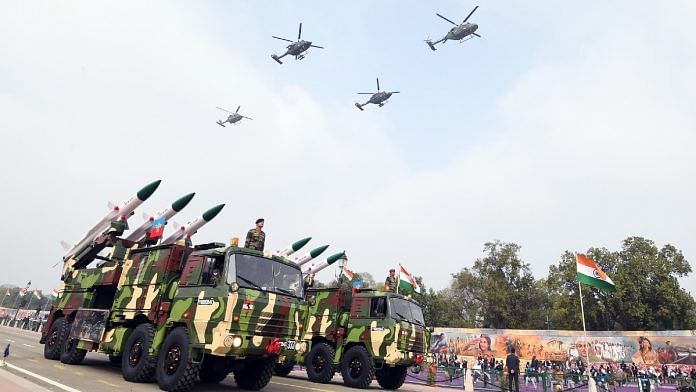New Delhi: Besides being the day the Indian Constitution came into being, Republic Day is particularly significant for the country’s armed forces because 26 January 1950 marked the removal of the ‘Royal’ prefix from the Navy and Air Force post-independence.
It also marks the day the then Royal Indian Navy (RIN) ceased to be the senior-most of the three services at the time. Back on 26 January 1950, the army became the “senior service” and that Republic Day marked the only time the ‘Royal’ Navy led the parade.
Commodore Srikant Kesnur, a naval historian, posted a detailed Twitter thread on how the end of the British Raj and India’s independence meant that various military units and departments were rechristened on the inaugural Republic Day. “…the Royal Indian Navy became the Indian Navy & His Majesty’s Indian Ships became Indian Naval Ships,” he tweeted.
Folks, apart from the many reasons why 26 Jan is our foremost national day, it has significance at many levels for the Armed Forces. And not for the spectacular parade or poignant ceremony at war memorial alone. For it was on 26 Jan 1950 that the prefix Royal was dropped from
— Srikant Kesnur (@srikantkesnur) January 26, 2022
“Before [Republic Day], in Dec 1949, the King’s Colour presented to the Royal Indian Navy in Dec 1935, were laid down along with many other Colonial Era Colour, at Indian Military Academy Dehradun…later, in May 1951, Indian Navy would be the first Service to receive the President’s Colour,” he added.
Cmde Kesnur also linked an article he had co-authored with Tiya Chatterji, a research assistant associated with the Naval History Project, which provides additional context.
Also Read: India’s 73rd Republic Day parade will have grand airpower that hides its strategic weakness
Navy ‘Indianising’ tradition
Following the removal of the ‘Royal’ prefix, the Indian Navy expanded the “Indianising” of its traditions during the prime ministership of Jawaharlal Nehru, “who embarked on the INS Delhi warship for a visit to Indonesia in June 1950”, according to Cmde Kesnur.
“During the voyage, on crossing the equator, the traditional crossing the line ceremony, that is a highlight of the maritime world, was held. When Neptune’s Court assembled for the ceremony & ‘mock trials’, it was informed that in accordance with new Constitutional norms it should now be designated as Varuna’s Court. Thus, Lord Varuna, the God of Oceans, has been presiding over our crossing the line ceremonies ever since,” he added.
Cmde Kesnur also brought the “Indianising” aspect full circle to present day by praising the navy for announcing the redevelopment of decommissioned warship INS Khukri as a museum and memorial for the earlier avatar of the ship and its crew, which were casualties of the 1971 India-Pakistan war off the coast of Diu.
“Fittingly, the recent incarnation will be based in that very place to serve as a memorial, a museum, a celebration of the nation, a commemoration of courage and poignant reminder of sacrifices needed to keep the nation secure. All of which epitomise the spirit of the Republic Day. And the Indian Navy with its blend of tradition & modernity reflects that spirit in full measure (sic),” he added.
Why Indian Army was never ‘royal’
Both the ‘Royal’ prefix for the Navy and Air Force in India, as well as the absence of such a label for the Army, have their roots in British military and political history, according to military law expert Major Navdeep Singh (Retd).
“The navy was the senior-most service in the UK, so that tradition continued here too. In the UK, it is called the Royal Navy and (the Air Force is the) Royal Air Force, but the Army is called the British Army as the former two are treated as services which were constituted by the monarchy. So, the same got transposed in India and the Army never had the Royal prefix,” he told ThePrint.
The creation of the British Army, meanwhile, dates back to the 17th century, when England was engulfed in a series of civil wars between 1642 and 1651, when the Parliamentarians, led by Oliver Cromwell, ultimately defeated the monarchy at the Battle of Worcester.
According to retired Canadian military officer and military law practitioner Rory G. Fowler, the modern-day British Army, which was formed in the early 18th century, has its “antecedents” with Cromwell’s New Model Army. “Even after the restoration of the monarchy [in 1660], it [the army] was not given a royal appellation,” Fowler said.
The professional army in the UK has its antecedents largely with Cromwell’s ‘New Model Army’. Even after the restoration of the monarchy, it was not given a royal appellation…
— Rory G Fowler (@RoryGFowler) January 27, 2022
Founded in 1546, the UK’s Royal Navy predates the English Civil War and is the UK’s oldest national service, while the Royal Air Force has its origins in “the Army’s Royal Flying Corps and the Royal Navy’s Royal Naval Air Service” during World War 1, Fowler added.
I’ll keep it mercifully short for your friends. The Royal Navy was the first ‘national’ service in the UK – hence it’s status as the ‘Senior Service’. It’s existence pre-dated the English Civil War. At the time, the Army was still raised under feudal norms…
— Rory G Fowler (@RoryGFowler) January 27, 2022
The Royal Air Force has its origins in two elements from World War I: the Army’s Royal Flying Corps and the Royal Navy’s Royal Naval Air Service. It was created 1 April 1918, on recommendation by Jan Smuts. The new RAF adopted modified ‘Naval’ terminology …
— Rory G Fowler (@RoryGFowler) January 27, 2022
(Edited by Gitanjali Das)
Also Read: Central Vista, old army uniforms—why this year’s Republic Day parade is a source of pride






